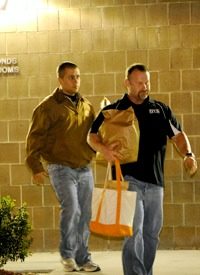
According to news reports, he posted a $15,000 bond — 10 percent of the total, as is typical — which his father may have raised by taking out a second mortgage on his house. Conditions for Zimmerman’s release included surrendering his passport, observing a curfew, and wearing a GPS monitoring device. There is also a prohibition on the consumption of alcohol or drugs, and a ban on the possession of firearms.
Reporters and photographers gathered at the Seminole County jail late Sunday night to witness the release. But according to news reports, unlike in the Casey Anthony case, the atmosphere outside the detention facility was calm — no shouting of questions and no protesters. Zimmerman did not give a statement.
Media accounts said Zimmerman, dressed in jeans and a brown jacket and carrying a paper bag, followed another man into a white BMW before driving away. It was not immediately clear where he went, but with the media circus surrounding the case, Zimmerman is expected to keep a low profile for his own safety. He may even leave the state if authorities agree to allow it.
In Sanford, Florida, the city where the shooting took place, the situation had already started to become less tense. "The mood in Sanford has calmed down tremendously," Sanford Commissioner Patty Mahany told the Associated Press. "I think now that people are able to see the justice system taking place, even though they understand it's going to be quite slow, people are willing to just remain calm and really we're all getting back to our daily routines."
Before Zimmerman’s arrest, race hustlers such as Al Sharpton and Jesse Jackson led massive protests. Black and white racists, meanwhile, threatened that a “race war” was imminent. No large-scale violence was reported.
On February 26, Zimmerman called police to report a suspicious person wearing a hoodie — 17-year-old Trayvon Martin — in his neighborhood, which had recently suffered from a series of break-ins. According to Zimmerman’s account, after he stopped following Martin when police told him it was not necessary, the black teenager attacked him, slamming his head on the concrete and breaking his nose. Zimmerman, who is Hispanic, said he responded by firing the fatal shot into Martin’s chest.
Prosecutors initially declined to press charges, citing evidence collected at the scene and witness statements supporting his claim of self-defense. A few weeks after the incident, however, racist hatemongers, President Obama, the United Nations, and the national media seized on the story — portraying it as a racist attack and demanding Zimmerman’s arrest.
Following weeks of protests and heated rhetoric, a Special Prosecutor appointed by Florida Gov. Rick Scott charged Zimmerman with second-degree murder. He turned himself in and appeared in court on Friday for a bond hearing. Though prosecutors resisted the defense’s requests for reduced bail, the judge in the case set the amount at $150,000 — indicating that, at the very least, the case against Zimmerman was not quite as strong as some activists and media outlets had portrayed it.
The same day as the hearing, a previously unreleased photograph — taken minutes after the shooting and showing blood dripping from the back of Zimmerman’s head — was published by ABC News. Legal analysts and commentators said the presumably new evidence raised serious questions about the prosecution and the national media coverage of the case.
Speaking publicly for the first time since the fatal shooting, Zimmerman apologized to Martin’s family during his bond hearing. "I am sorry for the loss of your son. I did not know how old he was. I thought he was a little bit younger than I was," Zimmerman said, addressing the slain boy’s parents. "I did not know if he was armed or not."
An attorney for the Martin family rejected the apology, blasting it as “self-serving.” But Zimmerman’s lawyer, Mark O'Mara, later explained why his client spoke out. "He didn't want to defend himself, he didn't want to discuss the facts of the case. He heard the request of the family, and he wanted to respond to it," O'Mara said.
If convicted of the murder charge, Zimmerman could face life in prison. However, legal analysts say such a severe charge would be very tough to prove to a jury beyond a reasonable doubt — especially because Florida law allows individuals to protect themselves from serious attacks with deadly force.
The day before Zimmerman’s release, his attorney told the press assembled outside the John E. Polk Correctional Facility in Sanford that his client understood that this will be "a long, long process." "He's still very worried about the fact that he's facing a life sentence on a second-degree murder charge," the lawyer said.
More than a few legal experts have suggested that prosecutors may have sought the murder charge to make it easier to obtain a plea bargain or a conviction for a lesser charge as the trial proceeds. However, it is believed that the state may have some evidence it has not yet revealed. No trial date has been set yet.
Related articles:
Zimmerman Injury Photo Raises Questions About Prosecution, Media
Prosecutors In Zimmerman Case Release Affidavit, But Face Trouble Getting Conviction
Zimmerman Charged With Second-Degree Murder
Racists Prepare for “Race War” Over Florida Shooting
UN “Human Rights” Boss Questions Fla. Law, Demands Justice for Trayvon
Media Unreliability in Zimmerman-Martin Case
Citing Potential “Hate,” Feds and Race Profiteers Descend on Florida
Anti-Gun Zealots Exploit Florida Tragedy
New Evidence Clashes With Preconceived Conclusions in Florida Shooting
Sharpton, Jackson, Media Silent About Hate Crime in S.C.
NBC Announces Investigation Into Altered Zimmerman Tape
Spike Lee Settles With Couple; Zimmerman’s Father Speaks
Media Matters’ Writer Apologizes After Bashing Drudge for Martin Photo
"Stand Your Ground" and Self Defense
Photo of George Zimmerman: AP Images


